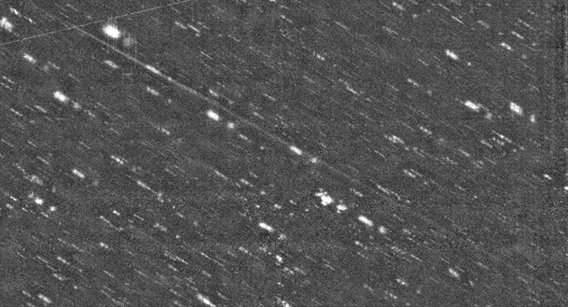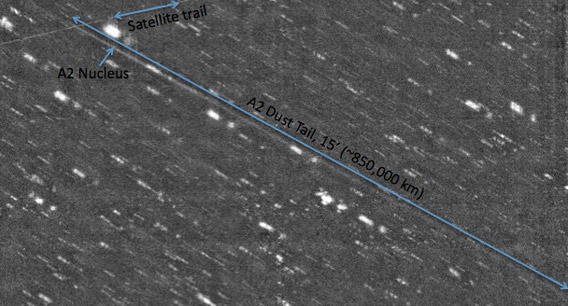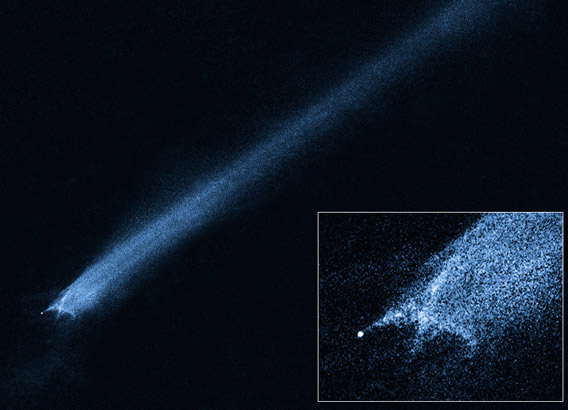Asteroid Masquerades as a Comet With a Million-Kilometer-Long Tail
In 2010, a very unusual asteroid was discovered. P/2010 A2 (LINEAR), as it’s named, looked more like a comet: It had a long tail stretching away from it. (Even the name is like a comet’s; the P stands for the “periodic” comet’s orbit.) Observations by Hubble taken a little while later showed it was even weirder: There was a bright dot that was ostensibly the solid part, but it was crisscrossed by streaks that looked as if the object had broken up!
It’s not a comet, though. Follow-up observations showed no gas at all in the tail as you’d expect from an actual comet; all they revealed was dust consistent with chunks about 1 centimeter across (about the size of a six-sided die) or smaller—the crisscross features were due to chunks of material flung off the main body into space. Clearly, this was an asteroid, not a comet. So why does it have a tail?
One possible explanation for this bizarre object is that the rock was hit by another smaller asteroid, an impact that would’ve had the explosive yield of a nuclear weapon, disrupting the asteroid and blasting out thousands of tons of dust. Another possible cause is a subtle process called the YORP effect, where the very gentle pressure of sunlight spun up the asteroid, increasing its rotation until it broke apart.
Observations at the time showed the tail was a few tens of thousands of kilometers long. But new observations taken with the One Degree Imager (ODI) camera on the WIYN telescope show the tail is far longer than first thought: It stretches away from the solid rock by a distance of at least 1 million kilometers, 2 1/2 times the distance from the Earth to the Moon!
The picture taken by the ODI shows just how long the tail is; despite being more than 100 million kilometers away from Earth, the tail is long enough to stretch out of the camera’s field of view.


[Grab the slider with your mouse to scroll between the image and an annotated one; note that this feature doesn’t work on mobile devices, which should display the two images separately.]
The image needs a little explanation. The asteroid—which is small, probably on the order of 100 meters across—is essentially invisible. Multiple exposures keeping the moving asteroid centered blurs out stars, making stubby streaks. The tail is obvious, far longer than the starry smears. A satellite makes a short trail cutting across the image at the upper left as well. The tail actually extends in front of the asteroid a little due to our viewing perspective and is at least 850,000 km long just in this image.
Observations taken over time indicate that whatever event created this tail happened about 3.5 years ago; the tail has been changing with time, giving astronomers a handle on its age. Whatever happened to it happened not long before it was discovered. The fact that the tail is this long is unexpected and will help astronomers understand the asteroid itself as well as the nature of the event that created this display.
Only a handful objects like this have been seen. Some appear to be asteroids that still have ice frozen in them; those tend to be in the outer part of the asteroid belt, far enough from the Sun that water exists as an ice. P/2010 A2 is inside that line, so any water on it is most likely long gone.
In 2007, Comet Holmes had a sudden disruptive event that created a huge expanding shell of dust around it that was visible to the naked eye even though the comet was past the orbit of Mars at the time—I saw it myself, and it was amazing. It’s possible that a smaller rock slammed into it, but it may have simply been a buildup of gas inside the comet bursting out.
We’re still somewhat new at finding objects like this, so we’re still learning about them. We’ve only visited a few comets and asteroids up close, but more space missions are either on their way or being planned for future encounters. These missions will yield huge amounts of knowledge about the leftover debris in our solar system. Asteroids can hit the Earth and cause havoc, they contain vast resources valuable for future crewed space missions, and they hold scientific value as some of the basic and ancient ingredients of the formation of the planets themselves.
Learning more about them is important for any and all of these reasons. Plus? They’re surprising, and that’s always a great first step on the path to scientific understanding.


